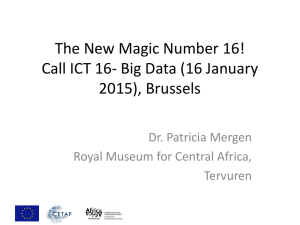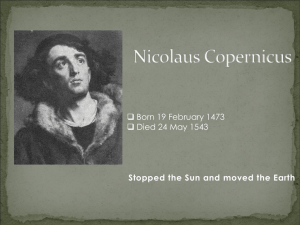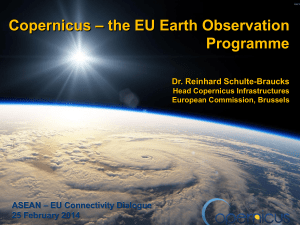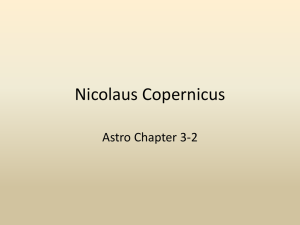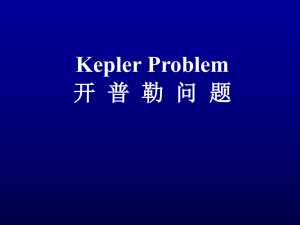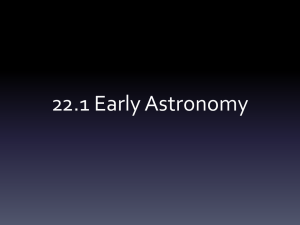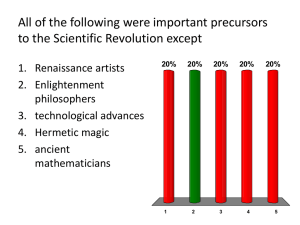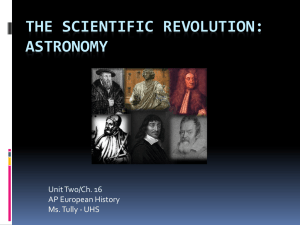CMU 2012 Ockham`s Razor, Forster
advertisement
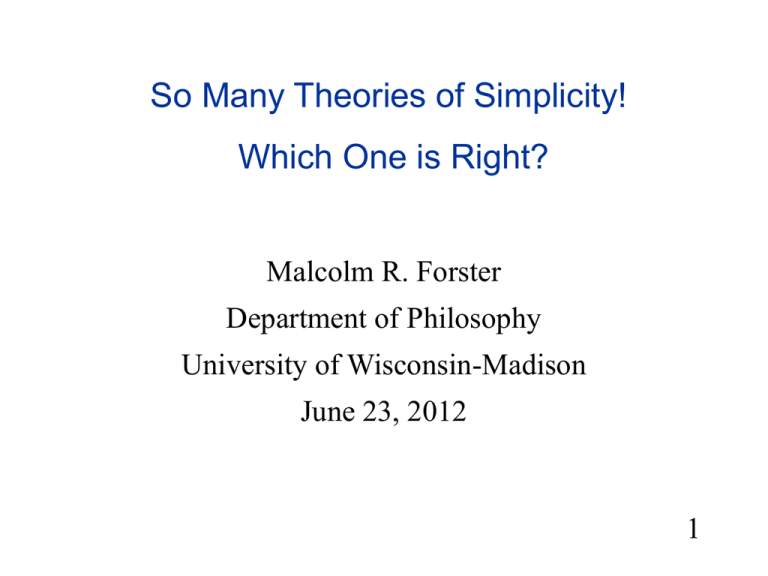
So Many Theories of Simplicity! Which One is Right? Malcolm R. Forster Department of Philosophy University of Wisconsin-Madison June 23, 2012 1 Abstract • For a long time, many assumed that simplicity is a sign of truth because the world is simple. • Popper complicated the story by saying that simplicity is falsifiability, so a simpler theory can be severely tested (and if it passes those tests, it is well corroborated). • Statisticians have pointed out that simpler models have fewer parameters, in which case each can be more accurately estimated, which leads to more accurate predictions. • Now Kevin Kelly has taught us how we more quickly converge towards the truth if we examine simpler theories first. • Which theory of simplicity is right? I want to say that all of them are mutually compatible, and most of them are right. 2 What I will actually talk about! What were the original examples in the history of science that motivated principles of parsimony and Ockham’s razor? An early example was Copernicus’s appeal to harmony as an argument against Ptolemy’s earthcentered system of planetary astronomy. How should we view this example, and other real scientific examples, in light of what we have learned about simplicity in recent years? 3 Disparate Examples of the Same Thing? Example 1: Copernicus versus Ptolemy Example 2: The time asymmetry of cause and effect. Example 3: Kepler versus Copernicus Example 4: The time asymmetry of cause and effect. 4 E m a 2 E mb 2 Copernicus (1473 - 1543) Sun-Centered Theory of the Planetary Motion “We thus follow Nature, who producing nothing in vain or superfluous often prefers to endow one cause with many effects. Though these views are difficult, contrary to expectation, and certainly unusual, yet in the sequel we shall, God willing, make them abundantly clear, at least to the mathematicians.” ---De Revolutionibus, Book I, Chapter 10. 6 Copernicus versus Ptolemy Mars Mars Earth Sun A Copernican submodel for Mars Earth Corresponding Ptolemaic sub-model for Mars 7 Two-Circle Copernican Model for Mars epicycle Mars deferent Sun Number of circles Copernican model; Radii, rates of motion, etc., are adjustable within the model. 8 Copernicus versus Ptolemy Mars Mars Earth Sun Another Copernican sub-model for Mars Earth The corresponding Ptolemaic sub-model for 9 Mars Copernicus versus Ptolemy Everyone has heard the expression “adding epicycles” used in a disparaging way. A common misconception is that Ptolemy used epicycles and Copernicus did not, therefore Copernicus’s theory was simpler than Ptolemy’s. FALSE! Note the title of this demonstration! http://www.youtube.com/watch?v=QVuU2YCwHjw 10 Copernicus versus Ptolemy The point of the Homer Simpson demonstration is that both Ptolemy’s and Copernicus’s theories can fit any data to any degree of precision. (Pure accommodation) So why did Copernicus supersede Ptolemy? Maybe Copernicus predicted some things better than Ptolemy? Problem: If we focus just on one planet at a time, then for any Copernican model, there exists a corresponding Ptolemaic model that is empirically equivalent. 11 The ‘anything you can do I can do just as well’ problem! 12 Common Responses to the Problem Copernicus’s theory is more explanatory than Ptolemy’s theory. Copernicus’s theory is more harmonious, simpler, or more unified than Ptolemy’s theory. Copernicus’s theory is more falsifiable than Ptolemy’s theory. Copernicus’s theory makes predictions that Ptolemy’s does not. 13 Copernicus versus Ptolemy I want to argue : 1. (Popper’s falsifiability criterion.) Copernicus’s theory was predictively more powerful. (E.g. the phases of Venus.) 2. At least some of these predictions were known to be true in Copernicus’s time? (Contra Popper!) 3. The reason Copernicus was predictively more powerful was that it was simpler, in some sense. 14 Copernicus versus Ptolemy In what sense is Copernicus’s theory simpler than Ptolemy’s theory? 15 Copernicus versus Ptolemy Take any Copernican model (that is, a version of Copernicus's theorem with a fixed number of circles for each celestial body), and then consider the corresponding Ptolemaic model such that the submodel for each celestial body individually is empirically equivalent (there is only one way of doing this). Each submodel is empirically equivalent because it simply adds the same circles (or scaled versions of them) in a different order. But the Copernican model will have fewer circles overall because Ptolemy has to "make" copies of the circles for the earth-sun component of the apparent motion of each planet. 16 Copernicus versus Ptolemy Jupiter Mars Sun Copernican model (3 circles) 17 Ptolemy Earth Mars Earth Sun Jupiter Earth The corresponding Ptolemaic model 18 Copernicus’s Prediction of a Coincidence Retrograde motion: One known fact not predicted by any Ptolemaic model: The retrograde motion of a superior planet occurs only if the planet is in opposition to the sun. Mars Earth Sun 19 Copernicus versus Ptolemy Recall, the Problem is that Copernicus and Ptolemy make the same predictions if we consider only one celestial body at a time. If we consider two or more celestial bodies at one time, then Copernicus’s theory does make predictions that Ptolemy’s theory does not make! Moreover, some of these predictions were determined to be true by the data known in Copernicus’s time. I also think that this was due to the greater unification of Copernicus’s theory. 20 Question Could we arrive at Copernicus’s theory in a data driven way? That is, could Ptolemy have noticed that epicycles in the submodel of Mars and Jupiter and Saturn have the same period as the circles for the SunEarth motion, and strengthened his theory by saying they are the same thing, giving Ptolemy+? Yes, but Ptolemy < Ptolemy+ < Copernicus. 21 So, what’s wrong with Ptolemy+ Why is Ptolemy+ < Copernicus? Because it does not require that the blue circles are literally the same circles (same radius as well as period!). There is something more than instrumentalism at work in this example. We have take seriously Copernicus’s talk of causes, where the postulated causes represent some aspect of reality behind the phenomena. 22 Why is Copernicus better than Ptolemy+ Given any Copernican model, the corresponding Ptolemy+ model has the same degree of confirmation with respect to the data known in Copernicus’s time. That is, it is empirically equivalent with respect to the prediction of the angular positions of all celestial bodies. But, Ptolemy+ does not put the Sun at the center of planetary orbits, does not predict the phases of Venus, and so on. 23 Why is Copernicus better than Ptolemy+ That is why we must consider fruitfulness as a criterion for theory choice in addition to confirmation with respect to current data. Copernicus’s theory not only makes some novel predictions that are known to be true, but is also predictively more powerful in ways that have not yet been checked. Perhaps fruitfulness can also be given an instrumental justification, but it is certainly not entirely data driven, which is my main point. 24 Copernicus (1473 - 1543) Sun-Centered Theory of the Planetary Motion “We thus follow Nature, who producing nothing in vain or superfluous often prefers to endow one cause with many effects. Though these views are difficult, contrary to expectation, and certainly unusual, yet in the sequel we shall, God willing, make them abundantly clear, at least to the mathematicians.” ---De Revolutionibus, Book I, Chapter 10. 25 William of Ockham, England (~1280 – 1347 AD) Occam’s Razor, or the Law of Parsimony “Entities must not be multiplied beyond necessity.” “What can be explained by the assumption of fewer things is vainly explained by the assumption of more things.” “Plurality is not to be posited without necessity.” 26 FORWARD CAUSAL MODEL P(win |1euro) Alice loss win 1 euro 90 10 2 euros 80 20 Bob loss win 1 euro 90 10 2 euros 160 40 P(win | 2euro) ˆ 0.1 ˆ 0.2 ˆ 0.1 ˆ 0.2 Independent measurements agree. 27 BACKWARD CAUSAL MODEL P(2euro | loss) Alice loss win 1 euro 90 10 2 euros 80 20 Bob loss win 1 euro 90 10 2 euros 160 40 P(2euro | win) ˆ 0.47 ˆ 0.67 ˆ 0.64 ˆ 0.80 Independent measurements do NOT agree. 28 The Asymmetry of Regression y • The data are generated from y = x + u, where x is N(–10,1), u is N(0,1) and u is independent of x. -6 -7 • The y on x regression is different from the x on y regression. -14 -8 -9 -12 -8 -6 x -11 -12 -13 -14 29 A Difference in Direction y • In the forwards regression model predicts the second data set (top right) better than the backwards regression model. 10 5 -10 -5 5 10 x -5 -10 30 What do these disparate examples have in common? How is the Forward Causal Model similar to Copernicus? The postulated “cause” is not an event. It is represented by a forward conditional probability. We do not write: PAlice (win |1euro) PAlice (win | 2euro) PBob (win |1euro) PBob (win | 2euro) (What would we predict if Carol played?) 31 Kepler versus Copernicus In the Copernicus versus Ptolemy example, the point has nothing to do with overfitting. (Copernicus makes novel predictions.) Kepler replaced Copernicus’s circles on circles with a single ellipse for each planet. The Homer Simpson demonstration makes the point that Copernicus can accommodate anything. But if there are as many adjustable parameters as data points, then it can’t be trusted for prediction. 32 Kepler versus Copernicus There is no possibility that Kepler can accommodate a Homer Simpson orbit, because there is only a single ellipse (with a small handful of adjustable parameters). Kepler tried 19 different oval shaped curves, and decided on the ellipse. Perhaps this was a lucky choice? 33 Kepler’s Model Mars ellipse Sun There is only one Keplerian model; initial positions, eccentricity, size, rate of motion, etc., are adjustable. 34 Kepler’s Third Law The ratio of the mean radius of a planet’s orbit cubed to the period squared is the same for all planets. For Newton, these ratios provided six independent measurements of the sun’s mass. 35 Newton’s Apple A story about the unification of celestial and terrestrial motion; of Kepler’s law applied to the moon, and Galileo’s theory of projectile motion. 36 The Concept of Acceleration Galileo’s thought experiment for his law of circular inertia. Galileo thought of uniform circular motions as inertial, therefore the moon was outside the influence of the earth’s gravity. 3 7 Newton’s Innovative Conception of Acceleration… v v v + v Earth …as a quantity with direction and magnitude (a vector). 38 Newton’s Consilience of Kepler’s and Galileo’s Inductions The agreement of independent measurements of the Earth’s gravitational mass… …explains celestial and terrestrial motions as effects of a common cause… …rather than effects of two separate causes. 39 Newton’s Rules of Hypothesizing RULE I: We are to admit no more causes of natural things than are both true and sufficient to explain their appearances. To this purpose the philosophers say that Nature does nothing in vain, and more is in vain when less will serve; for Nature is pleased with simplicity, and affects not the pomp of superfluous causes. 40 RULE II: Therefore to the same natural effects we must, as far as possible, assign the same causes. EXAMPLE: Newton assigned the same cause to the motion of the Jupiter’s moons and the displacement of the center of the orbits of the planets outside Jupiter–namely, the gravitational influence of Jupiter, as measured by its gravitational mass. 41 To sum up… Some of the arguments from simplicity have something to do with minimizing sampling error and avoiding overfitting (e.g. Kepler’s solution to the Homer Simpson problem). Others, such as Copernicus’s “argument from harmony” and Newton’s argument for universal gravitation have to do with postulating one cause for many effects. 42 The End

